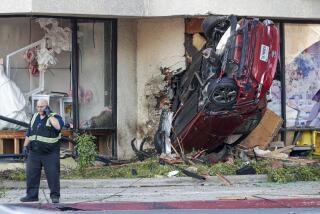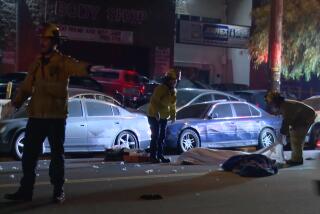Road Fatalities Escalate With SUV Crashes
WASHINGTON — Rollover crashes involving sport utility vehicles claimed an increasing number of lives last year, while fatalities in passenger cars went down, the government reported Wednesday.
There was an 11% increase in SUV crash deaths; a 3.8% decrease in passenger car fatalities.
Overall, 43,220 people were killed on the nation’s highways in 2003, an increase of 405 deaths from the previous year, according to preliminary figures from the National Highway Traffic Safety Administration. That represented the highest number of deaths since 1990.
“That’s a line I never wanted to cross -- 43,000,” said Jeffrey Runge, a former emergency room doctor who heads the highway safety agency. “We were hoping for the first decline [in deaths] in many years.”
Among passenger car occupants, 778 fewer people were killed in 2003. But among people in SUVs, there were 456 additional deaths, with rollovers accounting for more than half that increase.
Auto industry officials said that the rise in SUV fatalities correlates with the increasing popularity of the vehicles, but safety groups said the numbers bolstered the case for stricter government regulation. A bill pending in the Senate would set deadlines for NHTSA to require a series of safety improvements, including a stability standard for passenger vehicles. The Senate bill is part of a massive highway construction measure now pending in Congress, but the House version does not include such requirements.
“What this shows is that SUVs continue to dominate the fatality debate,” said Joan Claybrook, president of the Public Citizen advocacy group. “These deaths and injuries would be highly preventable with the provisions in the Senate bill.”
SUVs ride high off the road, making them more prone to tip in emergency maneuvers than ordinary cars. NHTSA, on its own, plans to move forward later this year with new requirements for side-impact protection and roof strength. Those new standards should help people in passenger cars that are broadsided by SUVs, as well as occupants of SUVs and pickups in rollovers.
Motor vehicle crashes are the eighth leading cause of death for Americans. They are the top cause of death from ages 4 through 33, and for toddlers aged 2, according to a recent NHTSA analysis.
Motorcycle fatalities increased last year by 11%, to 3,592, as more states abandoned mandatory helmet laws. Nearly half of the motorcyclists killed were 40 or older, reflecting the continuing popularity of bikes among aging baby boomers.
And the number of people killed in crashes involving large trucks edged up, despite a continuing campaign to promote truck safety and to educate other motorists about the dangers of driving near trucks.
The number of highway deaths had declined from the mid-1970s to the early 1990s, even with more cars and drivers on the roads. Those improvements have been attributed to the introduction of air bags, better vehicle engineering and stronger laws to promote seat belt use and deter drunk driving.
But the trend has been worsening since the late 1990s, and many safety experts believe it will continue to worsen unless side air bags, stability control systems and other innovations are widely adopted.
Not all the statistics for 2003 were bleak. The number of injuries in crashes declined by 1%. Pedestrian deaths fell by nearly 3%, and the number of fatal crashes involving teen drivers dropped by nearly 4%. Alcohol-related fatalities went down slightly.
When measured against the number of miles driven by Americans, the overall highway fatality rate remained unchanged. But Runge of NHTSA took little comfort in that, recalling the high fatality rates of the 1960s and 1970s.
“Despite the progress we have made, unless we continue to drive down the rate, we will be back up to 50,000 dead in 2008,” he said. “And that is not acceptable.”






